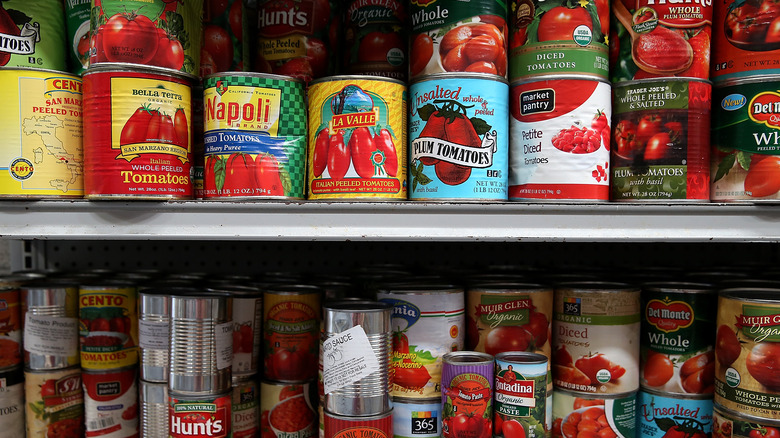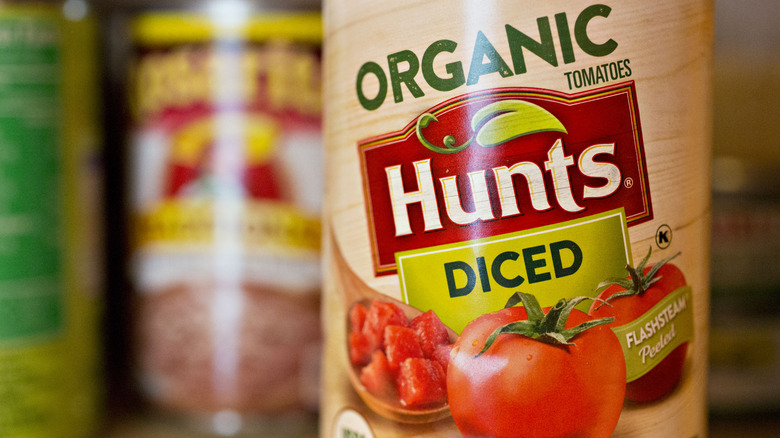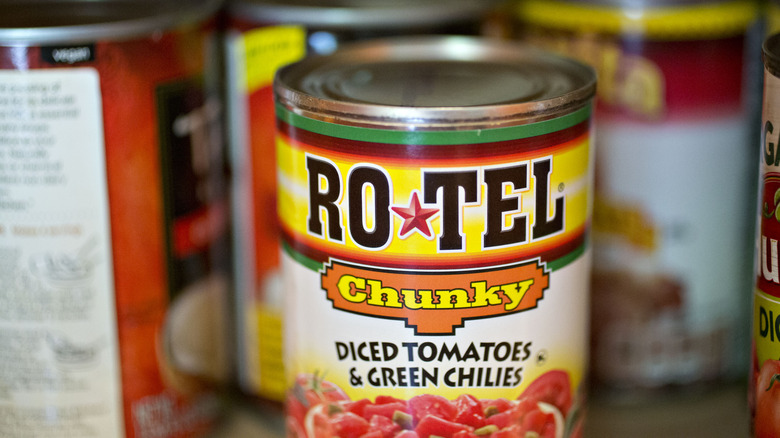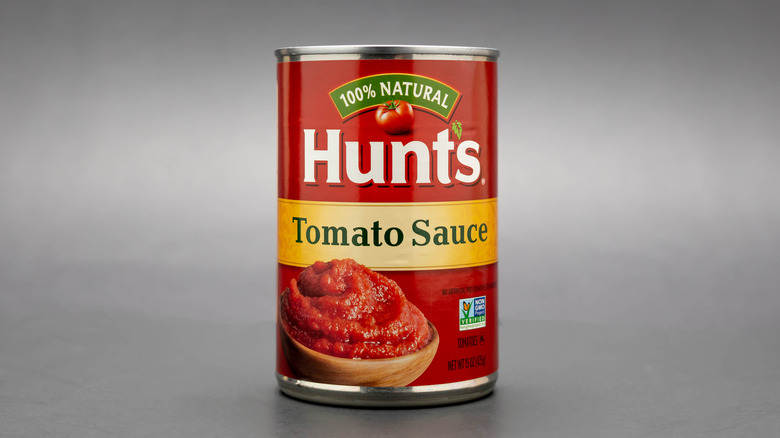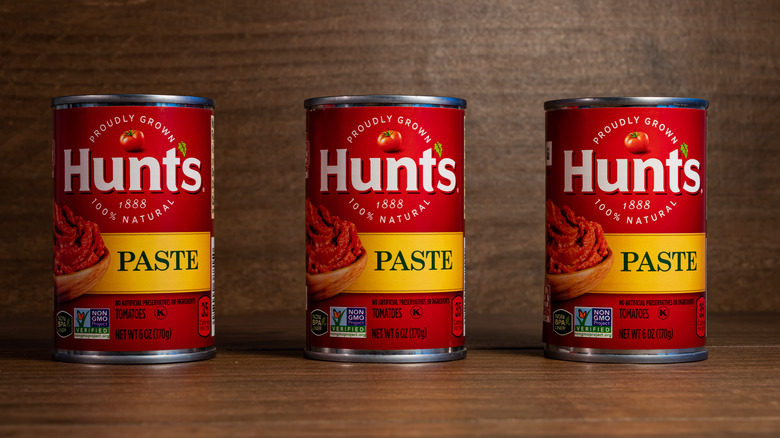10 Types Of Canned Tomatoes, Explained
There is a huge misconception that you should only ever cook with fresh tomatoes for the highest-quality food. However, all tomatoes are not created equal. Bite into a bland, out-of-season tomato, and you'll understand why fresh is not always best. In reality, fresh tomatoes are very different from canned ones. Nothing compares to a salad with a fresh summer tomato. When in season, this fruit masquerading as a vegetable just needs a little seasoning for peak enjoyment. If you are not eating them raw, you may be doing yourself a disservice by turning to fresh tomatoes.
It turns out that canned tomatoes are better for cooking — they have more concentrated flavor and can withstand heat better than fresh ones.
Psst! We've got the secret to picking high-quality canned tomatoes. Simply look at the label. If the can lists a specific variety of tomato, you can probably trust it is of high-quality. This is especially true if you are looking for San Marzano tomatoes, which carry a protected D.O.P. status (via European Commission). Whether you care about the specific tomatoes used or not, don't shy away from the canned tomato aisle. You can enhance your cooking by choosing the best canned product for all your cooking needs.
We understand how it can be overwhelming with the variations, so we came up with this guide for deciphering the 10 most common types of canned tomatoes.
Whole peeled
The least processed of the canned tomatoes — whole peeled — are just as they sound: whole tomatoes (primarily plum aka "Roma") peeled either through a quick steaming or water bath. Sometimes you will see them sold in their juices, but most often, they sit in tomato puree with herbs like basil added for flavor. Like every other product on this list, most cans of whole tomatoes on the market contain citric acid and calcium chloride as a preservative. This helps to maintain the structure of the tomatoes.
Many chefs and food connoisseurs claim that the best tomatoes are used for whole canning. While there is no concrete evidence of this, you will often see people recommend only buying whole canned tomatoes to get the best quality in all your cooking. The most prized whole canned tomatoes are San Marzano. This variety originates from Southern Italy, and to be labeled as San Marzano, the tomatoes must be grown in the region that shares its name (via The Chef & The Dish). If you see these tomatoes in any other form besides whole, they are likely fake. You will never see pureed San Marzano tomatoes in the grocery store. Look out for the D.O.P. label if you want the true product.
Diced
This next variety is probably the most commonly found on the ingredient list in recipes as well as in homes. From chili to pasta dishes, you probably crack open cans of diced tomatoes frequently in everyday cooking. The product contains firm chunks of vine-ripened tomatoes in their juices, and it's a common pantry staple for its convenience. You don't have to fuss with chopping the tomatoes. They can be thrown right into a pan from the can. Diced tomatoes can also be a great choice because they cook down faster than whole ones.
You can drain canned tomatoes, but a lot of flavor is retained in the juices. This is why we recommend not discarding the liquid to take the flavor of your canned tomatoes up a notch. Just keep in mind there may be some situations where you don't want the extra liquid, such as when using them as a pizza topping. For the most part, however, use the whole can.
Petite diced
Petite diced are essentially the same thing as diced tomatoes, only smaller. They will cook down even more quickly than their larger counterparts. You can reach for a can of these tomatoes when you need to get dinner on the table in a hurry. Because they contain all the same ingredients, a can of petite diced tomatoes can easily work as a substitute when a recipe calls for diced tomatoes. You can also shave a few minutes off of your cooking time. Similarly to regular diced tomatoes, the tomatoes and juices can be used.
Sometimes, you just might want the smaller pieces of tomatoes anyway. When drained, petite diced tomatoes can be thrown into a quesadilla or on top of pizza. They are also an ideal size for bruschetta. Additionally, these tomatoes could be an appropriate choice for making jammy tomatoes that still has some distinct chunks to it.
Fire roasted
If you think canned tomatoes lack flavor, you might not be buying the type that best suits your tastes. There are a few options on the market with some added flavor. Fire roasted tomatoes are an under-appreciated variety that can add great depth to your recipes. By roasting the tomatoes over open flames before canning, these tomatoes have a punch of smoky flavor that lend themselves well to Southwestern cuisine. A lot of versions on the market also contain garlic, onion, and sometimes jalapeños for added flavor.
Fire roasted tomatoes can be found in diced and crushed form. The diced version can make salsa that mimics the char of a grill, while the crushed ones can be transformed into a smoky tomato soup. However, don't feel like you need to limit yourself to Southwestern food. You can use this variety in virtually any recipe that calls for either diced or crushed tomatoes.
Diced with green chiles
What would Super Bowl Sunday be without diced tomatoes with green chiles? A hallmark of Tex-Mex food, these canned tomatoes are most often referred to simply as RO-TEL, which is the most popular brand name that carries this product. When a recipe calls for a can of RO-TEL tomatoes, they most likely mean the original variety, although RO-TEL actually sells 10 varieties from Mexican-style to the newest offering: Chipotle. The original recipe (which consists of diced tomatoes, fire roasted green chiles, and a little cilantro) is what is most commonly combined with melted Velveeta cheese for the classic Tex-Mex queso.
The RO-TEL brand comes from rather humble beginnings. In 1943, Carl Roettele started a canning factory in Elsa, Texas (via RO-TEL). For the first several years, they only shipped their products as far away as San Antonio, Houston, and Dallas. You couldn't even get these canned tomatoes with green chiles outside of the state of Texas. Now the name RO-TEL is ubiquitous with queso and Southwestern food.
Stewed
Stewed tomatoes are a canned item you do not hear much about anymore, but it is the product that Del Monte claims put them on the map. Their original recipe is made by slowly simmering tomatoes with onion, celery, and green bell peppers. This variety is most often seen as whole slices rather than diced chunks, making it unlike any other product on this list.
Because these tomatoes go through a longer cooking process, they have time to build flavor prior to going into the cans. They would work well in situations where you want that stewed flavor without having to stand by the stove for hours. When you use them to make shakshuka, a traditional Middle Eastern dish, you can get that depth of flavor while still maintaining some of the structure of the tomato. Del Monte also suggests adding them to pot roasts, leaning into the old-school reputation of this product.
Crushed
A cross between diced tomatoes and tomato sauce, crushed tomatoes are another popular variety in the canned tomato market. The difference between diced tomatoes and crushed tomatoes is that the crushed version contains either tomato puree or paste mixed in with the diced chunks. Because of the added puree or paste, crushed tomatoes tend to be thicker than diced tomatoes that only contain their juices.
Similarly to diced tomatoes, crushed tomatoes are fairly quick cooking, making them a standard choice for a lot of pasta sauce recipes. The contents of the can look like a chunky tomato sauce. However, it is important to remember that this product is going to have a relatively raw taste to it, as the tomatoes were only briefly cooked to remove the skins. Crushed tomatoes still benefit from being cooked down on the stovetop to develop flavor in the sauce before serving in your favorite pasta dishes.
Puree
Tomato products with distinct chunks can give your food a more rustic, homestyle look, but sometimes you might want a smoother consistency to your sauce. This is where tomato puree comes into play. In general, canned tomato products tell you exactly what to expect in the name on the label, and tomato puree is no exception. The tomatoes are briefly cooked before being pureed smooth. The puree is strained to remove the seeds and skins. Tomato puree is thicker than crushed tomatoes and has been said to have a slightly deeper flavor.
Tomato puree is another common choice for pasta sauces. If you like a very homogenous sauce, canned puree would be a great starting point. You'll still want to develop flavor with ingredients like garlic and onions and fresh herbs, but you won't have to cook the tomatoes down as much, as it already has a sauce-like consistency. Tomato puree can also be used to help thicken and reinforce the flavor in tomato-based stews like chili.
Sauce
With all the varieties of canned tomatoes, it can be hard to know which product is best to use in each situation. For example, how do you know whether to pick up a jar of tomato puree or tomato sauce? If you open a can of each without a label, you might have trouble correctly identifying the products. This is because they are nearly identical. Canned tomato sauce is tomato puree that has been thinned out with water. Sometimes you will find herbs and other seasonings added, such as basil, garlic, and oregano, but the standard version contains just salt.
Canned tomato sauce is not ready to eat "sauce." You won't want to serve it over cooked pasta as you would a jar of store-bought pasta sauce. The tomatoes have not been cooked very long. The sauce will have a highly acidic taste and will need to be cooked down some to bring out the natural sweetness of the tomatoes.
Paste
Despite being sold in smaller quantities than other tomato products, why does it still seem like no one can use a whole can of tomato paste once opened? This is probably because it only takes a couple tablespoons to get the full effect of this product. If tomato puree or sauce is the base of your pasta sauce, think of tomato paste as the boost to kickstart the flavors. This is the most concentrated tomato flavor you can find on the market.
The difference between tomato sauce and tomato paste is time. Tomato paste is made by cooking down tomato sauce until it has reduced into a deep red paste. Tomato paste is not seasoned, or it would taste far too salty after being reduced. A little goes a long way when using this thick paste to transform any tomato-based dishes. Keep in mind the long cooking process creates a condensed sweetness that can overtake a dish. A touch of acid, such as vinegar or wine, can help balance out the sweetness when cooking with tomato paste.
